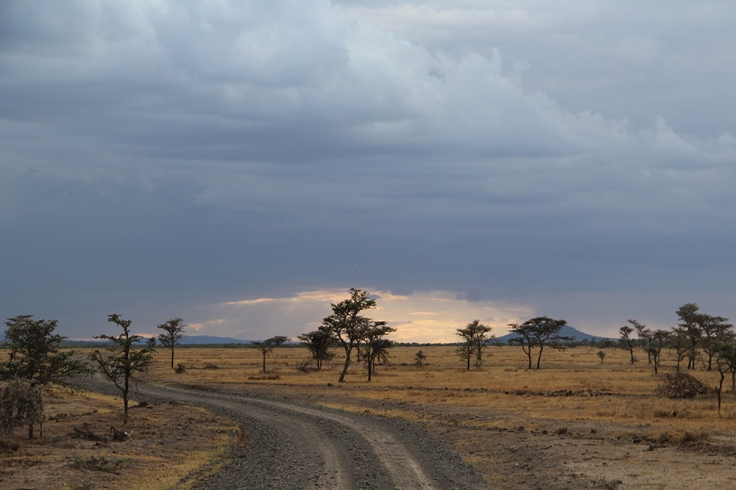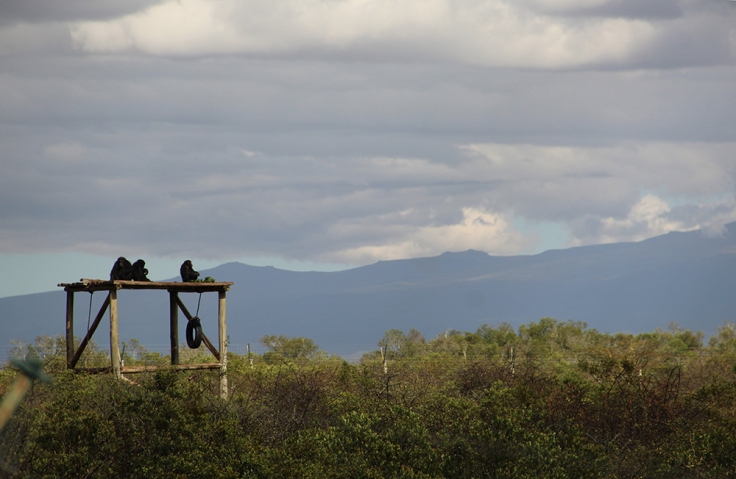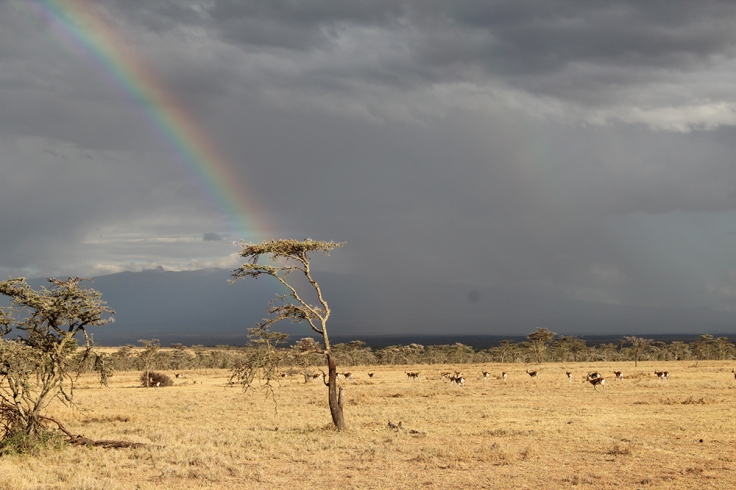This is an example of Kenyan self-sustained conservancy, where communities can still benefit from their motherland, human-wildlife conflict is greatly managed and poaching is being kept under control.
So, I wanted to go on a safari for my birthday, not too far away from Nairobi city and, most importantly, I wanted it to be sustainable both conservation and community wise. So I asked my safari-guru where to go and he pointed straight at Ol Pejeta Conservancy (a conservancy is a private natural reserve).

In this post, I will try to describe how this conservancy works while, on Part 2, I’ll write on my experience there. Please, check here if you want more general guidelines for organising truly sustainable (and affordable) safaris – they are a delicate thing indeed.
There are too many things to say about Ol Pejeta Conservancy. It has a chimpanzee and a rhino sanctuary; it is home to two of the world’s last remaining northern white rhinos; it has one of the largest wildlife densities of the area; it works in synergy with local communities and still provides them access to their endemic lands, piloting a sustainable farming model that is able to mediate the human-wildlife conflict…and it’s just stunning. You would enjoy riding around it even without seeing its incredible animals. It is even pretty close to town and easy to reach.

I have to admit, it has a bit of a business feeling. But it’s a well-running and sustainable business (not at all like one of those bad conservancies I’ve written about here). It is a non-profit organization and one of the few financially independent conservancies cross Africa. Making a conservancy economically feasible is hard, especially if you want to do it the right way. Knowing that this conservancy is not dependent on external donations but is able to run itself was indeed surprising.
This is why it is featured on the IUCN’s coveted Green List of Protected Areas and is one of its world’s 40 most distinguished locations, of which only two are situated in Kenya.
When it comes to visitors, it can offer a variety of arrangements, from spartan camping to luxurious lodges, and offers very peculiar additional activities, such as getting to know its anti-poaching dogs and testing them.
But let’s analyse some of my favourite features of this magic place:
Sweetwaters Chimpanzee Sanctuary
Remembering this sanctuary always leaves me filled with bitter grief. I know all about wildlife trafficking, poaching and the like and I knew all about them when I visited Sweetwaters. But its arcade, simply explaining the stories of its chimpanzees, subtracted to wilderness and sold as pets, witnessing the brutal death of their families before being taken to a life of solitude –and solitude is such a torture for these deeply social animals- and captivity, hurt me nonetheless. I think it’s a wonderfully done little museum, informative and impactful.

After visiting this brief exhibition, you can actually get to the enclosures of the rescued chimpanzees. I was sceptical at first, as always when I see captivity mixed up with conservation. But I was reassured, seeing this not-wild-anymore creatures finding comfort in a group of fellow chimps and having wide and wild spaces still available. Of course, you cannot interact with the chimps besides offering them peanuts from the other side of the fence, supervised. I’d say, considering these animals cannot be reintroduced into the wild and will lead their life in captivity, they still get a decent lifestyle.
So, indeed, I’m filled with bitterness for what human beings have done to these apes but I am relieved to have seen what I believe is one of the best captive accommodations they could find. Surely, it is better than the one they had before being rescued.

The rhino sanctuary
Ol Pejeta has a wonderful and rich population of both white and black rhinos, free to roam the conservancy (122 black rhinos and 32 southern white rhinos). But it also has a fenced sanctuary that is home of two of the last remaining northern white rhinos, females. It also provided shelter to the last male northern white rhino, named Sudan, that died on March 2018, euthanized after an impossible worsening of his conditions due to his age.

These animals are guarded 24/7 by trained rangers, as well as Baraka, a blind black rhino that was rescued and will spend the rest of his life looked after. It is possible to meet him, feeding him from behind the fence of his large enclosure. He is free to wonder off if he wants to, so I like to think he doesn’t dislike a bit of human attention. And he is gentle.
You can also visit the conservancy rhino cemetery, where all the rhinos of the past, whether lost to poaching or not, are still celebrated.

The wild part of the conservancy
This is where you can find wilderness and what the Conservancy really is about. There are more visited areas, especially close to lodges and water, as well as wilder ones, unexplored and unknown. You can experience them by driving on you own or guided by an expert ranger.
Its settings greatly vary from one hectare to another, showing off incredible biodiversity and even ecosystems. Some parts of it are dominated by Mount Kenya that offers stunning sun dawns.

But animals are the reason we visit such places. All sorts of Africa wildlife can be found here, with no exception. From the classic big five (lion, leopard, rhino, buffalo, elephant) to the most discrete –but still remarkable- species. I won’t list them, they’re just too many.
Human-wildlife conflicts, local communities and the fight against poaching
This is my favourite part. How can a conservancy run while still allowing cattle grazing and supporting the presence of human communities within its borders? Ol Pejeta explains it all.
Conflicts between conservation and local anthropic activities have more often than not serious ethical implications. Some parks even deport locals to preserve their wilderness. Some others are managed by foreigners that seize profit from their natural resources, leaving nothing to the people that have managed that very land for centuries, sustainably or not, using it as a fundamental source of livelihood – suddenly deprived of it.
But this is not what happens here. Here local communities are free to use the land for cattle grazing, their main source of income. And information on wildlife movements is constantly shared between these communities and staff, in order to prevent human-wildlife conflicts and both economic (crop waste and raids from herbivores and predations to cattle from carnivores) and conservation damages.

Locals can even sell their products within the conservancy and their communities are supported by several infrastructure initiatives (for education, water, health and energy).
This is one of the successful examples of coexistence. These models we need now more than ever and, being European, I am confident saying that we’d have much to learn for managing our own human-wildlife conflicts. Our problems are minor if compared to these African settings but we bloat about them as if they were the most tremendous, without apparently getting close to any solution (ever heard of the super discussed topic of the coming back of wolves all around the European continent? It’s getting out of hand).

As for poaching, on this January Ol Pejeta celebrated a year without poaching. And this is indeed an awesome result, considering the rate of poaching that affects Kenyan conservancies and parks and considering the amount of rhinos and elephants roaming on these lands. This result was achieved thanks to cooperation with neighbouring conservancies, communities and public institutions.
Conclusions: if you are not sure about if you are choosing a sustainable conservancy and still want to see tons of wildlife, just go to Ol Pejeta.
I will follow up with Part 2 as soon as possible, writing about my experience camping in Ol Pejeta and the marvellous creatures we encountered during our safaris. It was the best birthday I ever had.

Do you know any other conservancy, in Africa or not, that you’d deem sustainable? Or do you have terrible examples you’d wish us to avoid? Any good story on human-wildlife conflict? I’m ever curious about them and there is still so much to learn…
Oh, and if you’re passing by Nairobi on the way to your next safari, check this post with a ton of tips on where to eat.

This is a great post! Full of great information and a crisp, clear layout. I’d never heard about Ol Pejeta before, but it seems like an amazing place!
LikeLiked by 1 person
Super glad you enjoyed and found it useful! For what is worth, it was amazing for me indeed. And the best part is that it is very close to a network of other conservancies so, if you have time, you get to visit so many more of them.
LikeLiked by 1 person
If there a a bunch of conservancies nearby, then the area around Ol Pejeta seems like a place where one could really embed themselves and start to feel at home.
LikeLiked by 1 person